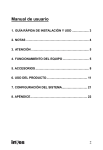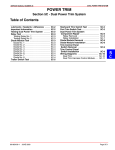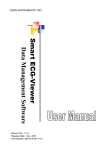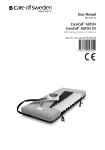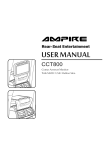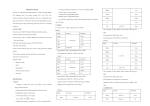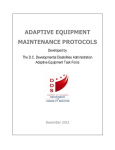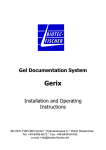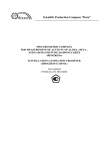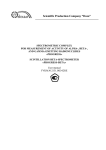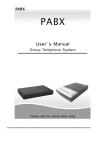Download User Manual
Transcript
436210 OKP SСIENTIFIC AND PRODUCING COMPANY «DOZA» CLINICAL X-RAY DOSIMETER DRK-1 Operating manual ФВКМ.412113.017РЭ Table of contents 1 Description and operation of the product…………………………………………...……. 1.1 Product designation……….……………………………………………………… 1.2 Technical features ………………………………………………………………. 1.3 Product composition……………………………………………………………… 1.4 Arrangement and operation……....……………………………………………… 1.5 Marking and sealing ……………..……………………………………………… 1.6 Packing …………………………………………………………………………... 2 Intended use………………………………………………………………………………. 2.1 Operating limitations ……………………………………………………….…… 2.2 Safety precautions when preparing the product for use ..……………………..… 2.3 Preparing the product for use ..…………………………………..……………… 2.3.1 Placement and assembly……………………………………………………….. 2.3.2 Functional test of the dosimeter……….………………………………………. 2.4 Use of the product ...……………………………………………………………... 2.4.1 Performing the measurements…………………………………………………. 2.4.2 Setting date and time ……..……………………………………….…………… 2.4.3 Nonvolatile memory handling …………………………………………………. 2.4.4 Estimation of effective dose to a patient ……………………..………………... 2.4.5 Checking consistency of operation of X-ray machines ……....………………... 3 Maintenance ……………………………………………………………………………… 3.1 General instructions……………………………………………………………… 3.2 Safety precautions………………………………………………………………... 3.3 Maintenance procedure ………………………………………………………….. 4 Verification procedure………………………..………………………………………….. 4.1 General requirements…………………………………………………………….. 4.2 Operations and facilities of verification………………….……………………… 4.3 Safety requirements ……………………………………………………………… 4.4 Verification conditions……..……………………………………………………. 4.5 Performing the verification…………………………………………………….… 4.6 Processing of measurement results………………………………………………. 4.7 Drawing up of verification results ………………………………………………. 5 Routine repair ………………………………………………………………………......... 6 Storage …………………………………………………………………………………… 7 Transportation ……………………………………………………………………………. 8 Utilization ………………………………………………………………………………... 3 3 3 4 5 6 6 7 7 7 7 7 8 8 8 9 9 10 10 11 11 11 11 12 12 12 13 13 13 14 14 14 14 15 15 Appendix A. Diagram of installing the clips on the ionization chamber ……………….…. 16 ФВКМ.412113.017РЭ 2 This operating manual ФВКМ.412113.017РЭ covers design, operating principal, characteristics of the product and indications necessary for proper and safe use of the product (intended use, maintenance, routine repair, storage and transportation), and also information about utilization of the product. 1 DESCRIPTION AND OPERATION OF THE PRODUCT 1.1 Product designation The clinical X-ray dosimeter DRK-1 ФВКМ.412113.017 (henceforth referred to as the dosimeter) is manufactured in compliance with the requirements of the technical conditions TU 4362-004-31867313-98, and intended to: - measure the product of absorbed dose in air and cross-section area of an X-ray beam at the X-ray machine output (henceforth referred to as the dose-area product); - estimate the effective dose to the patient during X-ray diagnostics and roentgenotherapy, using the appropriate procedures; - control consistency of operation of X-ray machines in the course of their use. The dosimeter is a fixed lab measuring instrument, and is used in medical institutions for all basic types of Russian and foreign X-ray machines (radiological, photofluorographic, surgical, angiographic, mobile), except for dental, mammographic and tomographic X-ray machines. The dosimeter has an integrated printer to print measurement results on a paper tape. The dosimeter may be used with two ionization chambers at once. With this, the second ionization chamber operates in the accumulation mode as well as an independent measuring channel. The dosimeter has a feature of data transfer through information links, and provides access to the processed data via the RS-232 interface-based links. 1.2 Technical features 1.2.1 Operating range of anode voltages of the X-ray emitter is 30 to 200 kV. 1.2.2 Range of the detected dose-area product ...…………………….………...1 to 104 cGycm2. 1.2.3 Limits of a relative intrinsic error of the dose-area product measurement for a confidence probability of 0.95 ………...…………………………………………………………….. (15+35/D) %, where D is a non-dimensional quantity that is numerically equal to the dose-area product value in cGycm2. 1.2.4 Dependence of the dosimeter sensitivity on radiation energy in the operating range of anode voltages of the X-ray emitter ……………..……………………………... no greater than 25 %. 1.2.5 The dosimeter sensitivity 1 min later after power-up differs from this 15 min later after power-up for ……….………..……………………………………..…………….. no greater than 10 %. 1.2.6 Change of the dosimeter sensitivity depending on the irradiated area … no greater than 5 %. 1.2.7 Dependence of the dosimeter sensitivity on absorbed dose rate ….... no greater than 10 %. 1.2.8 Uniformity of the dosimeter sensitivity over the ionization chamber area.… no less than 95 %. 1.2.9 Leakage current of the ionization chamber provides the reading increment for 1 h of work in the absence thereof an external radiation exposure …..………………….. no greater than 1 cGycm2. 1.2.10 Transparency of the ionization chamber for visible light …..….……...…...… no less than 70 %. 1.2.11 Attenuation equivalent of the ionization chamber at the anode voltage of 100 kV, percentage ripple of the production voltage is no greater than 10 % of the overall filtration of 2 mm ………………………………………………………………………. no greater than 0.5 mm Al. 1.2.12 Warm-up time .…….……………..…………………………...….. no greater than 1 min. 1.2.13 Measurement of the dose-area product using the dosimeter is synchronized with work of the X-ray machine, with this, continuous operation time ……………………………… no less than 6 h. ФВКМ.412113.017РЭ 3 1.2.14 Data delay interval ……...….……….………..……..………………. no greater than 5 s. 1.2.15 The dosimeter has an electrical operability and constancy monitoring system. 2 , 5 1.2.16 Power supply .…………………………….…………...…..….… ~ 230 23 34 ,5 V, 50 2 ,5 Hz. 1.2.17 Power consumption …………………………..…….…………… no greater than 50 VA. 1.2.18 Nonvolatile memory size ..……………..….…...…… no greater than 100 measurements. 1.2.19 Width of a printing paper ...……………………………………......………. 50 to 56 mm. 1.2.20 The printer cartridge replacement life ..........….……...... no less than 250 000 characters. 1.2.21 Environmental climatic factor values while using the dosimeter under operating conditions in compliance with GOST 15150-69: - operating temperature range ……………………………………………….. +10 to +35 °С; - limit value of a relative humidity …………………….…………………… 75 % at +35 С; - atmosphere pressure in the range of …………………………..…………. 84.0 to 106.7 kPa; - corrosion-active agent content in air conforms to an atmosphere type I. 1.2.22 The dosimeter is stable and strong against sine vibrations in the frequency range of 10 to 55 Hz with a bias amplitude of 0.35 mm. 1.2.23 Protection level being provided by the dosimeter enclosure is IP40 according to GOST 14254-96. 1.2.24 By level of protection against electrical shock, the dosimeter is referred to class I according to GOST 12.2.007.0-75. 1.2.25 By fire-resistant features, the dosimeter conforms to GOST 12.1.004-91 with a fire probability of no greater than 10-6 1/year. 1.2.26 Weight of the dosimeter ........................…………….………..…… no greater than 2 kg. 1.2.27 Overall dimensions, no greater than: - measuring console……......................……………………......................... 30022080 mm, - ionization chamber ……........................………….………….................... 18018020 mm. 1.2.28 Connecting cable length …..…..…………….…………….……… no greater than 20 m. 1.3 Product composition 1.3.1 The dosimeter consists of the light-transparent ionization chamber, measuring set (henceforth referred to as a control panel) and connecting cable (extender) to connect the chamber to the control panel. 1.3.2 The ionization chamber is a plastic case into which a plexiglass plates are pasted, and two conductive plates (electrodes) are mounted. The communication cable with a measuring console is mounted into the case on a side panel. The delivery set contains self-tapping screws and a pair of metal clips (slides), by means of which the chamber is pushed into the latch mechanism of the X-ray emitter aperture with a standard fastener system. 1.3.3 The control panel is made as a separate ergonomic unit equipped with an integrated power cable, power switch and grounding terminal. The panel involves an electronic circuit for processing signals being received from the ionization chamber, a display device and data output device (integrated printer) as a set. ФВКМ.412113.017РЭ 4 1.4 Arrangement and operation 1.4.1 The light-transparent plane-parallel ionization chamber presents two electrodes with airfilled space between them. To one of the electrodes, voltage of +400 V is applied, and the second one is intended to collect charges (electrons) having formed in the chamber under exposure to the ionizing (X-ray) radiation. Under exposure to X-ray, ionizing current flows through the chamber. Charge having transmitted through the chamber in the course of exposure is proportional to the dose-area product. 1.4.2 Charge having transmitted through the chamber charges a capacitor situated in the control panel. Capacitor voltage is measured with an electronic voltmeter made using an analog-to-digital converter (ADC). Data on achieved voltage and accumulated charge (Q = C·U, where Q is a capacitor charge; C is a capacitor capacity; U is a capacitor voltage) enter to the control panel microprocessor, where upon them the dose-area product is calculated. 1.4.3 Wide measurement range of the dose-area product is reached by installing into the control panel some capacitors of different capacities differing in order. As the charge of the preceding capacitor reaches the reference voltage, charge from the chamber will begin to be applied to the second capacitor, and so on until all the charge having transmitted through the chamber will be accumulated on the capacitors. 1.4.4 The front panel of the dosimeter control panel houses the control keys. Figure 1.1 shows a key arrangement on a control panel. The «WORK» key provides: - entry to the date and time setting mode; - reset to the normal standby mode. The «SCROLL» key is designed to: - select time parameters in the setup mode; - view the date - with the key pressed in the standby mode; - scroll through saved-in-memory parameters of the processes carried out. The «» and «» keys is designed to: - decrement/increment the selected parameter in the setup mode; - scroll through the records while scanning memory. The «STORAGE» key provides changeover from the standby mode to the memory scan mode. The «PRINT» key provides printing of the last measurement results or printing of the record selected while scanning memory. The «RESET» key is designed to clean the dosimeter readings and switch to the measurement mode, reset the system in case of hang-up (hang-up symptom – glowing single digit on the display, or completely dim display). The «TEST» key provides preliminary functional test of the dosimeter. The «PAPER FEED» key provides paper feed in the printer. 1.4.5 The display shows: - dosimeter-measured dose-area product value under normal operation or in the memory scan mode; - dosimeter settings in the date and time setting mode; - error message, if appears, during functional test of the dosimeter. ФВКМ.412113.017РЭ 5 Figure 1.1 – Key arrangement on a control panel 1.5 Marking and sealing 1.5.1 The case of products involved in the dosimeter contains the following markings: - trade mark and/or manufacturer’s name; - reference designation of the dosimeter; - serial number according to manufacturer’s numbering system; - mark of pattern approval; - year of manufacture; - power, voltage or current, frequency; 1.5.2 Position and method of marking, type size meet the requirements stated in the design documentation. 1.5.3 Sealing of the dosimeter is performed in compliance with the design documentation. 1.6 Packing 1.6.1 The dosimeter is packed to meet the requirements for category KU-3 according to GOST 23170-78. 1.6.2 The inner package of the dosimeter meets the requirements of GOST 9.014-2005 for group III protection version V3-10, packing version VU-5. Protection period without re-conservation is 3 years. 1.6.3 Packing is performed in closed ventilated spaces with an ambient temperature of + 15 to + 40 °С and relative humidity up to 80 % at +20 °С and corrosion-active agent content in air not exceeding this specified for atmosphere of type I by GOST 15150-69. ФВКМ.412113.017РЭ 6 2 INTENDED USE 2.1 Operating limitations 2.1.1 The dosimeter stays operable under conditions described in 1.2. 2.1.2 Care should be taken to protect the dosimeter against undesirable weather impacts: increased humidity of air, temperature jumps. 2.1.3 Do not install the control panel near radiators and heaters. 2.1.4 When cracks or chips appear on the ionizing chamber case, further use of the chamber is forbidden. 2.1.5 The ionizing chamber should not shift in the guide slides of the X-ray aperture more than for 2 mm, under any position of the X-ray emitter. 2.2 Safety precautions when preparing the product for use 2.2.1 Personal continuously or temporarily involved in handling the sources of ionizing radiation, must follow requirements stated in «Principal Sanitary Radiation Safety Rules (OSPORB99) SP 2.6.1.799-99» and «Radiation safety standards (NRB-99) SP 2.6.1.758-99». 2.2.2 Failure of the dosimeter does not pose irradiation hazard since there is no an electrical connection to the X-ray machine control circuits. 2.2.3 Maintenance of the dosimeter should be performed in compliance with «Rules of technical operation with consumers’ electrical installations» and «Safety rules for operation with consumers’ electrical installations». 2.2.4 Only properly trained and having electrical safety qualification level III personnel are allowed to perform repair and adjustment of the dosimeter. 2.2.5 Before turning on the dosimeter, make sure that insulation of a power cable is safe, and grounding is available. 2.2.6 The dosimeter must be safely grounded. Grounding should be made regardless of degree of the space hazard in which the dosimeter is mounted. Protective grounding must enabled first, and disables last after the supply voltage is off. 2.2.7 In case, if insulation fault or electric circuit failure occurs, immediately stop use of the dosimeter and switch it off. The damaged power cable should be disconnected from mains and replaced. Do not remove the pin plug holding the cord. 2.2.8 Never let the communication cable to be squeezed. Be particularly careful when cabling in the area where the X-ray machine stand moves. 2.2.9 Be sure to disconnect the AC cable from mains, when replacing fuses as well as the printer cartridge or paper roll. Never open the dosimeter sooner than 10 minutes after power-off. Be sure to install fuses of the stated rate and type. WARNING! NEVER WORK WITH THE DOSIMETER WITH COVERS AND HOUSING REMOVED. 2.2.10 Should contingency such as inflammation of the dosimeter technique or ingress of water into enclosure, mechanical damage of the ionization chamber occurs, immediately switch off and disconnect the power cable from mains. Take appropriate steps keeping in mind that use of the dosimeter under extreme conditions may result in electric shock. 2.3 Preparing the product for use 2.3.1 Placement and assembly 2.3.1.1 Unpack the dosimeter. Make sure that completeness of the set conforms to the equipment certificate ФВКМ.412113.017ПС. Check safety of the manufacturer's seals, absence of damages of the dosimeter technique and conformance to factory numbers recorded in the equipment certificate. ФВКМ.412113.017РЭ 7 2.3.1.2 The dosimeter should be grounded using grounding terminals on the backside of the control panel. Grounding should be made regardless of degree of the space hazard in which the dosimeter is mounted. 2.2.1.3 Fasten the metal clips (slides) from the delivery set on the ionization chamber case using self-tapping screws. Diagram of installing the clips on the ionization chamber is given in appendix A. Distance between guides and their orientation may be changed by loosing the self-tapping screws. 2.3.1.4 Gently push slides of the ionization chamber into the latching mechanism of the X-ray emitter aperture. 2.3.1.5 Connect the ionization chamber to the control panel inserting the cable connector of the ionization chamber into the «CHAMBER 1» or «CHAMBER 2» socket on the backside of the control panel. 2.3.1.6 Connect the power cable plug to mains. With this, the power switch located on the side panel of the control panel should be in the «0» position. Check if the power cable is properly connected, and has no damages. Check if grounding is available. 2.3.1.7 Put the power switch located on the side panel of the control panel to the «I» position. With this, indicators on the front panel should lit, and after the readings in first two digits of the display change, the zero readings (Р 0.0) will be set. 2.3.2 Functional test of the dosimeter 2.3.2.1 Warm up the dosimeter within 1 min. 2.3.2.2 Press the «TEST» key on the front panel, with this, change of readings in first two digits occurs, after then the zero readings will be reset if the test result is successful or Er – if failure is detected. 2.3.2.3 In case of test failure, disconnect the dosimeter from mains, check connection of the ionization chamber, connecting cables and connectors, and turn on the dosimeter again. If the test fails again, contact the manufacturer or repair service. 2.3.2.4 In case of successful test, go to measurements. 2.3.2.5 When turning on the dosimeter for the first time after: 1) transportation and long-term storage; 2) change of climatic conditions; 3) long-term outage; 4) mounting or replacement of the connecting cable in the X-ray machine, ATTENTION! WARM-UP TIME MAY BE 15-30 MIN (I.E. WHEN PRESSING THE «RESET» KEY, ON EXPIRY OF THAT TIME ZERO READINGS (Р 0.0) SHOULD APPEAR ON THE DISPLAY, AND THEY SHOULD REMAIN INVARIABLE UNTIL RADIATION IS APPLIED TO THE CHAMBER). DURING FURTHER USE THE WARM-UP TIME SHOULD BE IN ACCORDANCE WITH TECHNICAL CHARACTERISTICS. 2.4 Use of the product 2.4.1 Performing the measurements 2.4.1.1 To start the new measurement resetting the display readings, press the «RESET» key on the front panel of the control panel. The dosimeter starts measurement after changing first two readings of the display. 2.4.1.2 On expiry of exposure time (X-ray exposure time), on the control panel display, the dose-area product value (cGycm2) will appear. To print the result, press the «PRINT» key. With this, the result is printed on a form and saved in memory. The form contains the following information: - dosimeter number; ФВКМ.412113.017РЭ 8 - procedure number; - time (hh. mm. yy); - date (dd. mm. yy); - dose-area product (Dose, cGycm2); - space for the radiologist’s signature. After printing the measurement results, the dosimeter readings are automatically cleared. In memory, time and date of the measurement, its serial number among measurements carried out in the course of that day, and dose-area product value are saved. The dosimeter allows to print data of any saved result. Detailed description is given in point 2.5. 2.4.1.3 If necessary to make several X-ray exposures in the same projection, do not clear display readings after each exposure. If this, the result of each subsequent measurement will be added to the preceding value. The final result will be an accumulative value over all measurements of the dose-area product. 2.4.2 Setting date and time 2.4.2.1 This section is intended for specialists involved in service, repair or adjustment of dosimeters. Correctable parameters: Minutes – В0 Hours – В1 Date – В2 Month – В3 Day – В4 Year – В5 2.4.2.2 To turn on the dosimeter, put the power switch to the «I» position holding pressed the «WORK» key. With this, the (- - - - - - - -) message will be displayed. 2.4.2.3 Press the «SCROLL» key. With this, the В1 message and astronomical-time clock will appear. To set the desired value, use the «» and «» keys. 2.4.2.4 Press the «SCROLL» key twice again. With this, the В2 message and month number will appear. Subsequent double pressings on the «SCROLL» key allows to select the following parameters: В3 - month, В4 - day, В5 - year, В0 – minutes and В1 – current time value again (by cycle). To set the desired value, use the «» and «» keys. 2.4.2.5 To quit the time setting mode, cancel the point on the third position of the display by pressing the «SCROLL» key once. ATTENTION! THE DOSIMETER SOFTWARE DOES NOT PROVIDE CHECKING THE CORRECTNESS OF SETTING THE PARAMETERS. 2.4.3 Nonvolatile memory handling 2.4.3.1 The dosimeter has a nonvolatile memory that allows saving up to 100 measured data. Besides, a nonvolatile real-time timer involved in the dosimeter set allows to state date and time of each measurement. 2.4.3.2 To work with measurements saved in memory, press the «STORAGE» key on the front panel of the control panel. With this, the serial number of the last measurement for the current day and time of the measurement will appear. Using the «» and «» keys you may view the measurement performance chart. When pressing the «SCROLL» key, the dose-area product obtained during this measurement will be displayed, when pressing the key twice, date relevant to this measurement will appear. To leave the memory handling mode, press the «WORK» key. ФВКМ.412113.017РЭ 9 2.4.4 Estimation of effective dose to a patient 2.4.4.1 Source information for estimation of effective dose to a patient using a dosimeter is as follows: - anode voltage value at the X-ray tube, kV; - thickness and material of the optional filter (in this manual an optional filter of 2 mm Al in thickness is assumed); - dose-area product over the period of X-ray procedure performance, cGycm2 ; - examination area (lungs, skull, etc.); - projection (anterior-posterior, posterior- anterior, lateral); - radiation field size (height and width at the image detector), cm2; - focal distance (distance from the X-ray tube focus to the image detector), cm; - patient age (0 to 0.5 years; 0.5 to 3 years; 3 to 8 years; 8 to 13 years; 13 to 19 years; elder than 19 years). 2.4.4.2 Determination of individual effective doses Е to patients using a dosimeter is carried out in compliance with methodic instructions for monitoring methods MUK 2.6.1.760-99 «Determination of individual effective doses to patients during X-ray examinations using dose-area products meters». The value of an effective dose Е, Sv, to a patient of the given age when carrying out X-ray examination is determined as follows: Е = D · Кd , (2.1) where D is the measured value of the dose-area product, cGycm2; Кd is the factor of conversion to the effective dose to a patient of the given age with taking into consideration the type of carried out X-ray examination, projection, field size, focal distance and anode voltage at the X-ray tube Sv/(cGycm2 ). Values for factors of conversion to the effective dose for X-ray examination of different organs and systems are given in appendix 1 of MUK 2.6.1.1797-03. 2.4.4.3 The delivery set of the dosimeter in accordance with the order card may involve optional application software (ASW) «DRK1-Agent» and «BD-DOP», or ASW «DRK1-Monitor» ASW «DRK1-Agent» is intended to transmit data from a dosimeter to a computer. ASW «BD-DOP» allows to automatically calculate individual radiation-absorbed doses to patients, fill and maintain databases on individual effective radiation doses to patients, automatically fill in the form № 3-DOSE «Data on radiation doses to patients during medical radiological and nuclear examinations». ASW «DRK1-Monitor» comprises functions of both previous programs except for a feature of automatic filling of form № 3-DOSE. To employ the ASW, you need: 1) install the given software on your computer; 2) connect the dosimeter and computer using the communication cable RS-232, optionally involved in the delivery set in accordance with the order card. If a standard connector RS-232 is not available, use the USB – RS-232 adapter, optionally involved in the delivery set in accordance with the order card. Installation and work with software are described in the user’s guide optionally involved in the delivery set. 2.4.5 Checking consistency of operation of X-ray machines 2.4.5.1 The dosimeter may be used to check consistency of operation of X-ray machines in the course of their use. ФВКМ.412113.017РЭ 10 2.4.5.2 As a factor of consistency of operation of the X-ray machine the discrepancy of the ratio value of a mean dose-area product deviation and mean dose-area product value, S, over specified time intervals is used. To calculate this, it is necessary to: 1) take five readings of a dosimeter at different settings mAs, at a specified value of tube voltage and with an aperture maximum opened. Most high-usage settings mAs in the operating range are recommended. 2) determine the mean dose-area product value over five readings for all chosen settings mAs, Dср , using the equation j 5 D i Dср j where Di i 1 , 5 (2.2) is the i-th one from five values of the dose-area product at the j-th setting mAs. 3) calculate the mean dose-area product deviation at each setting mAs, ср j , using the equation 5 D ср j ср j Di i 1 5 (2.3) 4) calculate the ratio of the mean dose-area product deviation and mean dose-area product at all settings mAs, S j , using the equation Sj ср j Dср j (2.4) 2.4.5.3 The calculations within this procedure should be made separately for minor and major focuses. 2.4.5.4 Check of operation consistency of X-ray machines is carried out by comparing the values S j , obtained at the commencement of operation with values S j , obtained after 6 month intervals. The values S j for the same setting mAs should not differ more than for 25 %. Otherwise, the X-ray machine may be faulty. The actions that personnel should perform in such situation are described in the appropriate schedule of operations. 3 MAINTENANCE 3.1 General instructions 3.1.1 Maintenance of the dosimeter is carried out in order to provide its safety and serviceability over its total operation life. 3.1.2 Maintenance of the dosimeter is performed only by personnel having familiarized with this manual. 3.2 Safety precautions When performing maintenance of the dosimeter, safety precautions stated in 2.2 must be strictly followed. 3.3 Maintenance procedure 3.3.1 Maintenance of the dosimeter comprises preventive maintenance and current maintenance. 3.3.2 Preventive maintenance is carried out before starting works, and with this the following is examined: ФВКМ.412113.017РЭ 11 - external view of the dosimeter; - connecting cables fastening ; - safety of the power cable insulation and availability of grounding. 3.3.3 Current maintenance should be carried out once per week, with this the following is performed: - cleaning of the external surface of the dosimeter; - removal of faults detected during operation; - replacement of a printer paper or cartridge. To replace the printer paper, it is necessary to: 1) remove screws retaining the printer cover; 2) withdraw the expended roll former and place the new one; 3) cut smoothly the paper tape end using scissors and insert it into the reception slot of the printer; 4) press the «PAPER FEED» key and wait unless about two centimeters of the paper tape come out the printer. To replace the printer cartridge, it is necessary to: 1) remove the old cartridge; 2) place the new cartridge instead; 3) make sure that the ink ribbon is not jammed and completely enters into the slot between the type drum and printing head; 4) secure the cartridge on the latches; 5) rotate the printer axis in the direction indicated by an arrow to withdraw an excess ribbon; 6) return the printer cover and fasten the screws. 4 CALIBRATION PROCEDURE 4.1 General requirements 4.1 Calibration of the dosimeter should be carried out by territorial organs of the National metrology services or other legally authorized organizations having power of carrying out this kind of works. Requirements for management, calibration routine and form of presenting the calibration results are specified in PR 50.2.006-94 «National system for ensuring traceability. Procedure of performing calibration of measuring instruments». All first produced dosimeters, dosimeters which have undergone repair, and dosimeters being in normal use are subject to calibration. Initial calibration covers the first produced dosimeters and those which have undergone repair. Periodic calibration covers the dosimeters being in normal use. Re- calibration period is one year. 4.2 Operations and facilities of calibration When performing calibration, operations and facilities listed in Table 4.1 should be employed. ФВКМ.412113.017РЭ 12 Table 4.1 – List of operations and facilities employed when performing calibration Operation name 1. External examination 2. Testing 3. Determination of intrinsic relative error of measurement Paragra ph number 4.5.1 4.5.2 4.5.3 calibration facilities and their reference characteristics Visual Primary working standard of absorbed dose of photon radiation in air with an ionization chamber according to GOST 8.70-96. X-ray machine with tube voltage of 50÷200 kV. Auxiliary devices: barometer according to GOST 2369679 and thermometer according to GOST 27544-87. Mandatory performance of operation during initial periodic calibration calibration Yes Yes Yes Yes Yes Yes 4. Processing of measurement results 4.6 Yes Yes 5. Drawing up of calibration results 4.7 Yes Yes Note – You can use particular first developed or being in use facilities and equipment as long as those facilities and equipment have specifications at least as good as those listed in this verification procedure. 4.3 Safety requirements When performing calibration, safety requirements stated in 2.2 and documentation for calibration facilities and equipment employed should be followed. 4.4 Calibration conditions Calibration should be carried out observing the following conditions: - ambient temperature ……………….…………………...…………………… +(20 5) °С, - relative humidity …………………………………………………...……….. 30 to 80 %, - atmosphere pressure ………………………………………………..……... 84 to 106.7 kPa, - natural radiation background ………….…..….…….….………. no greater than 0.2 Sv·h-1. 4.5 Carrying out calibration 4.5.1 External examination With external examination, the following should be ascertained: - compliance of completeness of the dosimeter under calibration with technical description; - availability of maintenance documentation; - absence of dirt, mechanical damages on the instrument (measuring console and ionization chamber of the dosimeter) affecting its operation; - availability of mark of previous verification. 4.5.2 Testing Testing of the dosimeter consists in performing operations described in 2.3. 4.5.3 Determination of intrinsic relative error of measurement Calibration of the dosimeter is performed either with dismantling or without dismantling. ФВКМ.412113.017РЭ 13 4.5.3.1 Upon calibration with dismantling the dosimeter, an ionization chamber of the dosimeter under calibration is placed in the center of radiation field of the X-ray machine so as its plane would be perpendicular to the beam axis, and radiation field would cross all over the ionization chamber. Radiation field non-uniformity within the area of the ionization chamber should be within ±5 %. The value of absorbed dose in air is determined using the primary working standard, the ionization chamber of which is placed near the ionization chamber to be verified. To convert measurement units of the reference dosimeter, the ionization chamber to be verified should be closed against radiation by a metal screen with a window of the known area. With this, dose measured with the working standard is assumed to be the estimated value of readings of the dosimeter under verification. The calibration is carried out at the anode voltage of 100 kV. The ionization chamber is exposed to doses producing values of the product of dose D0 and chamber area S, equal to about 25, 300, 2000 and 10000 cGycm2. 4.5.3.2 Upon calibration without dismantling, as a primary working standard, the working standard based on the clinical X-ray dosimeter DRK-1 is employed. If this, verification is carried out by a comparison method in accordance with «Procedure of periodic calibration without dismantling» involved in the delivery set of the working standard. 4.6 Drawing up of measurement results Intrinsic relative error of measurement of the dose-area product is calculated in percents as follows D D0 100 , (4.1) D0 where D is the measured value of the dose-area product, cGycm2; D0 is the estimated value of the dose-area product, cGycm2. Results of the calibration are considered to be satisfactory if the limits of an intrinsic relative error of measurement of the dose-area product meet the requirements stated in 1.2.3. 4.7 Drawing up of calibration results 4.7.1 Satisfactory results of calibration of dosimeter are drawn up in accordance with PR 50.2.006-94. 4.7.2 Upon unsatisfactory results of calibration, notice of nonoperability of the dosimeter is issued or the appropriate record is made in the technical documentation, and use of the dosimeter is not admitted. 5 ROUTINE REPAIR 5.1 Routine repair of the dosimeter consists in restoring the damaged cables and connectors. The dosimeter elements are non-repairable, and in case of failure should be replaced or repaired at the manufacturer. 6 STORAGE 6.1 The dosimeter prior to putting into operation should be kept in a heated and ventilated storehouse: - in the manufacturer’s packaging under conditions 1(L) according to GOST 15150-69 at the ambient temperature of +5 to +40 С and relative humidity up to 80 % at +25 С; - without packaging - +10 to +35 С and relative humidity up to 80 % at +25 С under ФВКМ.412113.017РЭ 14 conditions of atmosphere type I according to GOST 15150-69. 6.2 Storage period without re-conservation is 3 years. 6.3 Storage premises should be free from dust, acid and alkaline vapors, corrosive gases and other harmful corrosion-causing impurities. Storage place should exclude entry of the direct sunlight on a dosimeter. 7 TRANSPORTATION 7.1 The dosimeter in the manufacturer’s packaging may be transported by all means of transport at any distance, under observation of the following conditions: - transportation by rail freightage should be carried out in covered clean boxcars; - upon transportation by open motor transport, the boxes with dosimeters should be covered by waterproof material; - upon transportation by air, the boxes with dosimeters should be situated in the airproof heated section; - upon transportation by water, the boxes with dosimeters should be situated in hold sections; 7.2 Placement and fastening of boxes with dosimeters in transportation facilities should provide steady position throughout the entire journey, protection against lading shifts and impacts 7.3 When loading and unloading, the inscription requirements stated on a shipping container should be observed. During handling operations, the dosimeter should not be subjected to effects of atmospheric precipitation. 7.4 Transportation conditions: 7.4.1 Values of environmental climatic factors in the course of servicing the dosimeter under workless condition (transportation): - temperature ……………………………………………..…….… minus 25 to +50 °С, under condition of smooth temperature stabilization during unloading to temperatures of + 10 to +35 С and further stay under normal conditions within 12 h; - humidity …………………………………..…..…………..………...... up to 98 % at +35 °С. 7.4.2 The dosimeter in a shipping container is stable against sine vibrations in the frequency range of 10 to 55 Hz with a bias amplitude of 0.35 mm (group N2 according to GOST 12997-84). 8 UTILIZATION 8.1 On expiry of total life time, the dosimeter must be dismantled, to exclude possibility of its further use, and sent to specially conditioned places in waste disposal spaces. ФВКМ.412113.017РЭ 15 Appendix А (recommended) DIAGRAM OF INSTALLING THE CLIPS ON THE IONIZATION CHAMBER Chamber Clips ФВКМ.412113.017РЭ 16
















